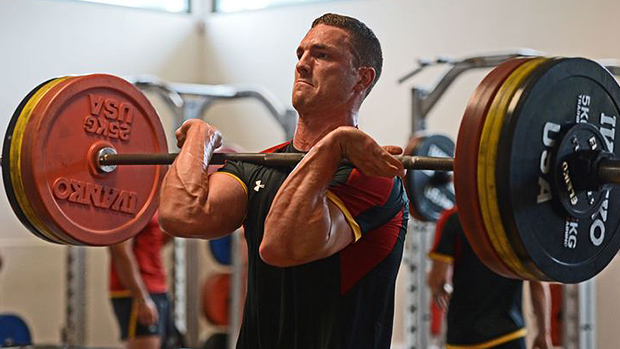The Romanian Deadlift, or RDL, is an excellent lift for developing strength and muscle mass in the posterior chain. Whether your goal is a great physique, a bigger squat or deadlift, or to run faster and jump higher, the RDL can help get you there.
Unfortunately, the RDL is one of the most difficult lifts to learn and coach. Whether it's the concept of neutral spine, loading the hips by pushing them back, or keeping the weight on the heels, let's just say there are easier lifts to coach! In fact, I'd go as far as saying I'd rather teach someone to squat properly than do an RDL properly!
Let's work from the top down to explain proper body alignment and performance of this lift.
Head and Neck
Proper alignment of the head and neck is critical while lifting, but especially in posterior chain dominant lifts such as the RDL. The chin should be tucked slightly, and the neck in a neutral alignment with the rest of the torso.
A few months ago I would've stated that the head and neck should be looking up, but I'm quickly changing my mind of this point. Excessive neck extension and/or looking up kicks on the extensor reflex, forcing you into an excessive lordosis. Not only can this increase stress on the low back, but it increases anterior pelvic tilt and makes it more difficult to maximally recruit the hamstrings and gluteals.
Chest
Throughout the RDL the chest should be up; a good rule of thumb is that if someone in front of you can't read your shirt, you're not doing the exercise properly! Keep the chest up throughout the lift.

This is quite difficult for most, but work on keeping the chest up without extending the neck excessively. Once you master this little nuance, you'll see a definite improvement in your performance and strength.
Low Back

The low back in a resting position should have a slight lordosis. The goal throughout the RDL should be to maintain that optimal curvature; you shouldn't be increasing your arch or letting your low back round into flexion. Neutral spine is key as it allows you to really blast the hamstrings and glutes.
Knees
This is another area where a lot of people screw up. To perform an RDL properly, you need about 15-20 degrees of knee flexion from the start. Too much knee flexion and you don't hit the hamstrings effectively. Too little and it turns into a stiff-leg deadlift where you round over and feel your lumbar discs shoot out the back side of your body!
Okay, they don't always do that but you definitely leave yourself at increased risk of injury if you go into spinal flexion under load.
A cue that I use with many lifters is to simply "soften" the knees at the start; this generally gets them into the appropriate position.
Feet
Your feet should be pointed straight ahead using a hip-width stance, and the weight should be shifted towards the heels. I often tell my athletes that weight training is the only sport I know of where being on your heels is actually a good thing!
Performance
- Grab the bar just outside of shoulder width; if grip is an issue, feel free to use a mixed-grip or straps.
- Set-up in a hip-width stance with the toes pointing straight ahead and weight on your heels. You should have a slight bend in the knees.
- The chest should be up, with the chin tucked and neck in neutral alignment with the rest of the torso.
- From the starting position, focus on pushing the hips way back. In fact, just think about pushing the hips as far back as possible while maintaining the flat back and neutral neck position.
- Once you feel a mild stretch in the hamstrings, drive the hips forward towards the starting position. If you start to feel any rounding in the low back before this, go ahead and return at that time.
- As you approach the starting position, focus on actively squeezing the gluteals to finish the lift.
Summary
Proper exercise technique is absolutely critical if you want to achieve success in the weight room. If you can master the RDL, arguably one of the most difficult lifts to learn, you'll be well on your way to becoming a weight-room god. Good luck!




